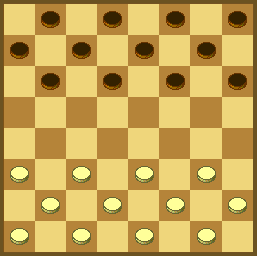
Setup for Stockholm checkers on a standard board.

Setup for Stockholm checkers on a standard board.
Stockholm Checkers follows the same rules as International Draughts and Brazilian checkers, except for one important difference: a Man may only capture backwards subsequently, as part of a capture sequence (“deferred backwards capture”). So it cannot capture backwards as immediate move.
A Man steps diagonally forwards. It captures, by the short leap, in all diagonal directions. A King slides and captures in all diagonal directions over any distance. It also jumps to capture, but only one Man at a time. A King may “fly” over empty squares (“long King”).
A Man promotes to King at the last rank. If a Man makes an intermediate landing on a promotion square and can continue capturing, it does not promote. One must continue capturing as long as possible. It is mandatory to select the longest capturing line. Captured pieces are removed only after the move is finished. The goal is to capture all the opponent’s pieces.
A variant features a halt rule is featured: a King must halt behind the last captured piece. This rule also occurs in Argentinian checkers (here). There is also a variant where it is not mandatory to capture the longest line.
The game is played on an 8x8 board with 12 pieces per player. Brazilian checkers (Minor Polish draughts), the forebear of this variant, was known already in the 16th century, and possibly even earlier. It was a popular board game in Holland, especially in Amsterdam.
Discussion
Most Western checkers variants belong to either of two groups, International/Polish (here) or Spanish (here). In the former, a Man may capture backwards; in the latter only forwards. The problem with backwards capture is that the defence becomes easy. Although a Man advances, it retains control of squares in the rear. The problem with the Spanish group is that it has less combinatorial complexity, due to less capture directions.
Stockholm checkers keeps the advantages of both. Although A Man can also capture backwards, it may only do this later, as part of a series. It means that the defence becomes more difficult. A Man may sneak behind the back of an enemy Man and reach a promotion square. This vouches for a less drawish game. Moreover, the advanced and interesting combinatorial aspects of International/Polish variants are retained. Arguably, the introduction of the deferred backwards capture rule is a significant improvement. Worse endgames will become more difficult to hold. Although this variant is an invention of undersigned, the rule already exists in a traditional Gothic (orthogonal) checkers variant (“Armenian checkers II”, here), where a Man may not capture southwards as immediate move. However, here the strategical impact of the rule is less pronounced.
 Here, White must choose the sequence that picks up two pieces, by jumping to the square marked green. Comparatively, in Brazilian checkers, White would be compelled to capture three pieces with the leftmost piece. But since immediate rearwards capture is prohibited in Stockholm checkers, this is not possible here.
Here, White must choose the sequence that picks up two pieces, by jumping to the square marked green. Comparatively, in Brazilian checkers, White would be compelled to capture three pieces with the leftmost piece. But since immediate rearwards capture is prohibited in Stockholm checkers, this is not possible here.
See also:
Winther, M. (2015). ‘International/Polish Checkers Variants’. (here)
------- (2017). ‘Spanish Checkers Variants’. (here)
------- (2017). ‘Gothic Checkers Variants’. (here)
------- (2017). ‘Draughts with Deferred Backwards Capture’. (here)
☛ You can download my free Stockholm Checkers Variants program here (updated 2022-02-21), but you must own the software Zillions of Games to be able to run it. (I recommend the download version.)
© Mats Winther (May 2017).